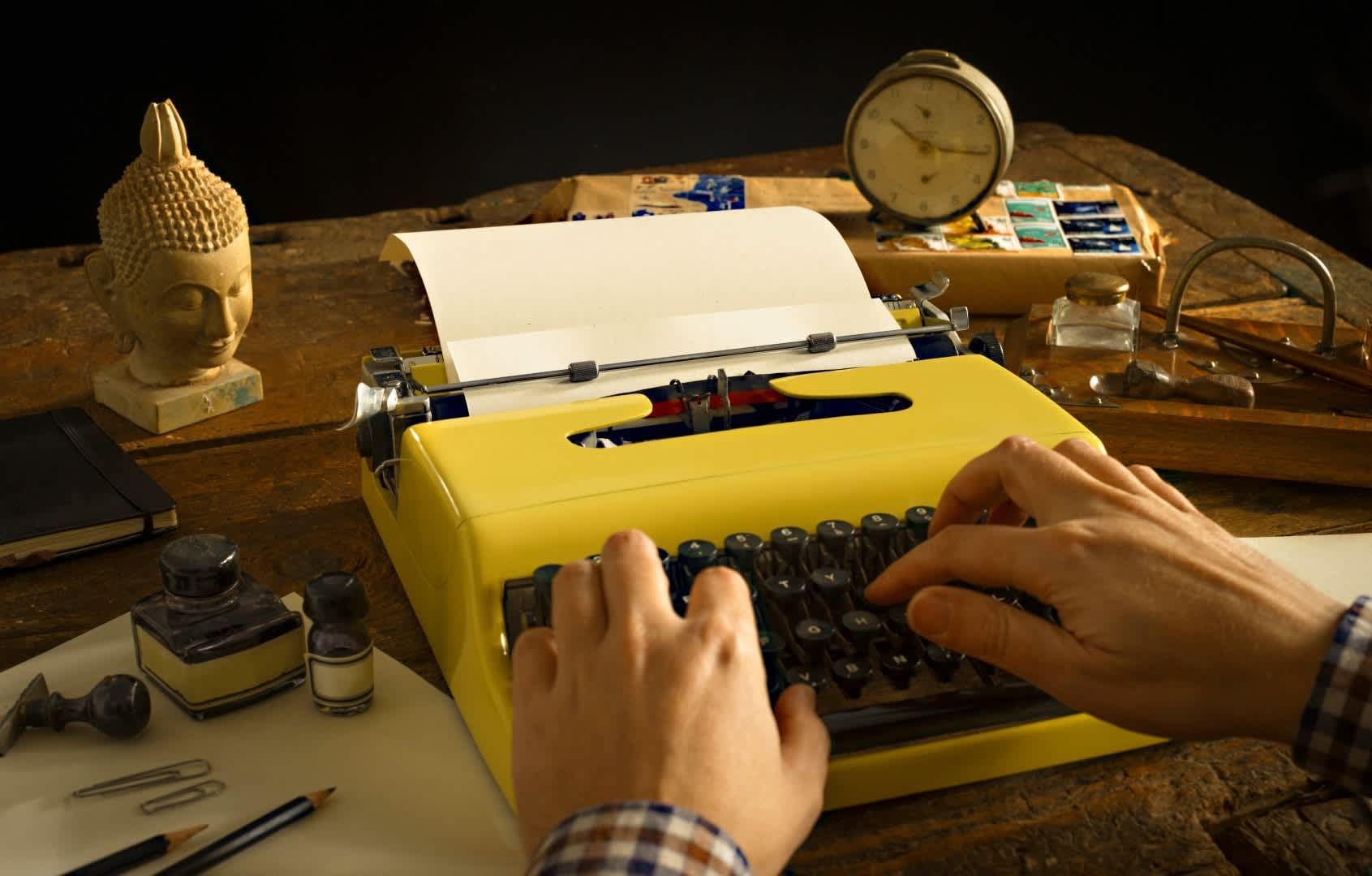From Typewriter to Keyboard: The Digitalization of Poetry

Posted on August 13th, 2024
As the typewriter gave way to the digital revolution, the keyboard became the poet's new muse. A different kind of click brought efficiency, flexibility, and a world of endless editing possibilities. Suddenly, the process of writing poetry transformed, becoming a fluid, dynamic endeavour. The ability to back up drafts, revise meticulously, and even experiment with new formats without the fear of permanently striking through your work introduced a kind of poetic freedom previously unknown.
The Evolution of Poetry: From Paper to Pixels
 The history of poetry has roots in oral traditions and the earliest written scripts. Poems were initially transcribed onto papyrus and parchment by scribes in ancient civilisations. This manual method of writing required painstaking effort and immense care. With the invention of the printing press in the 15th century, poetry became more accessible, allowing poets to see their works reaching larger audiences. This marked a significant step in how poetry evolved over time. Soon after, the beloved typewriter entered the scene, bringing with it a new way of composing and editing with efficiency.
The history of poetry has roots in oral traditions and the earliest written scripts. Poems were initially transcribed onto papyrus and parchment by scribes in ancient civilisations. This manual method of writing required painstaking effort and immense care. With the invention of the printing press in the 15th century, poetry became more accessible, allowing poets to see their works reaching larger audiences. This marked a significant step in how poetry evolved over time. Soon after, the beloved typewriter entered the scene, bringing with it a new way of composing and editing with efficiency.
The evolution of poetry continued as the typewriter served poets for decades until the introduction of computers. Computers fundamentally changed the landscape of literature. Word processors offered unparalleled flexibility, enabling poets to draft, edit, and format their pieces with ease. Additionally, the digital medium offered poets the ability to back up and recover their works, reducing the anxiety of losing precious lines to the universe. This period saw a dramatic shift in how poetry evolved over time. At your fingertips, you could now control the presentation, align text, and incorporate different stylistic elements seamlessly. The transition from paper to pixels broadened the horizon for poets, presenting new methods to share their voice with the world.
Digital Age Poetry: New Platforms, New Voices
Digital Age Poetry has undoubtedly been shaped by the emergence of new platforms, which has brought about an era where poets can share their voices more widely and diversely than ever before. Websites, blogs, social media platforms such as Twitter, and online journals have become vibrant stages for poets to present their work to the world. The sheer variety of these platforms enables poets to experiment with and refine their voice and style, providing them with tools and audiences that were once out of reach. For you as a modern poet, posting a piece of digital poetry online means immediate exposure and instant feedback, fostering an interactive dialogue between creator and reader that previous generations could only dream of.
The digital age has democratized the art of poetry, ushering in an era where voices from all walks of life can resonate on a global scale. This inclusivity brings a rich tapestry of perspectives into the literary world, enabling readers to experience diverse narratives and poetic forms. Platforms like YouTube and Instagram offer poets the ability to pair their words with visual elements, turning a simple poem into a sensory experience. The accessibility afforded by these platforms means that you don't need a publishing contract to have your work recognised; with the click of a button, your poem can be read and appreciated by someone halfway across the globe. This opens doors that were once tightly shut to marginalized voices, allowing them to be heard and celebrated.
Innovative Expressions: Verse in the Digital Age
Innovative expressions of verse in the digital age reflect an artistic evolution that harnesses emerging technologies to craft immersive experiences. Multimedia poetry exemplifies this trend by blending text with music, visuals, and even motion. Imagine reading a poem while ambient sounds of ocean waves and soft piano chords play in the background—this fusion enhances the emotional depth and sensory engagement of the piece. Poets use videos to accompany their readings, adding another dimension to their words that allows for a richer interpretation.
Interactive poems bring a dynamic element that traditional formats lack. Readers not only consume but also engage with the poem. They may click on certain phrases to reveal hidden stanzas or alter the narrative flow based on their choices. This approach transforms the reading experience into an active exploration, giving each reader a unique journey through the poem.
Technological advances have also birthed new forms unique to the digital realm. Consider the rise of code poetry, where poets integrate programming languages within their verses, creating compositions that are both literary and functional. Such works blur the lines between poetry and technology, highlighting the versatility of language. These creations often reflect on themes of human-computer interaction and digital existence, resonating deeply with contemporary audiences.
Types of Poetry in the Modern Era
The shift to digital poetry hasn't simply been about new tools; it has also invited new styles and structures. Traditional forms such as sonnets, haikus, and villanelles have certainly found their place online. Yet, their digital counterparts often adopt a more fluid approach. For instance, an online haiku might include hyperlinks to elaborate on imagery, offering readers deeper context. E-books and digital anthologies transform the reading experience with clickable notes and annotations, making the experience more interactive.
In addition to adapting classical forms, new types of poetry have arisen that are unique to digital environments. Hypertext poetry, where readers navigate through linked text that leads them to different narrative paths, epitomizes how the online medium can create a non-linear reading experience. Such poetry encourages readers to explore at their own pace, often resulting in multiple interpretations of the same work. The emergence of 'code poems' or 'algorithmic poetry' showcases how deeply interwoven our lives have become with technology. These poems not only follow traditional literary aesthetics but also involve elements of code, sometimes executable, adding layers of meaning that would be invisible in a purely textual format. For you, engaging with these new forms might initially feel unconventional, but they represent evolutionary steps that echo the historical shifts poetic forms have undergone through the ages.
Related: Captivate Your Audience: The Art of Spoken Word Poetry
Conclusion
Yet, as you navigate this ever-evolving digital landscape, it’s crucial to keep in mind that the core of poetry remains unaltered. Despite the shift to a digital platform, the essence of poetry remains rooted in those humble beginnings where you pour your soul onto the page. This is true even though the medium may now be digital. With the advancement of modern technologies, poetry has gained new layers and dimensions that were once unimaginable to early poets. These innovations have greatly enhanced the way we experience and share poetry, making it accessible to a wider audience than ever before.
At Dayo's Poems, our speciality lies in offering unique 'Dimensions of Poems,' connecting classic poetry techniques with contemporary digital tools. Are you seeking inspiration on your spiritual journey? Look no further than 'Déjà Vu, God Loves You: Not Impossible' by Adedayo Adeniji. This captivating collection of poems and writings offers a glimpse into the author's personal walk with God and Jesus, revealing how they have helped them grow in their God-given talents
. To learn more, contact us at 07400 307077 or email us directly at [email protected]. As you embrace these new digital dimensions in your poetic journey, know that all these advancements only serve to deepen the connection between poet and reader. So, embark on this transformative journey with us and let your words find new, far-reaching pathways.
